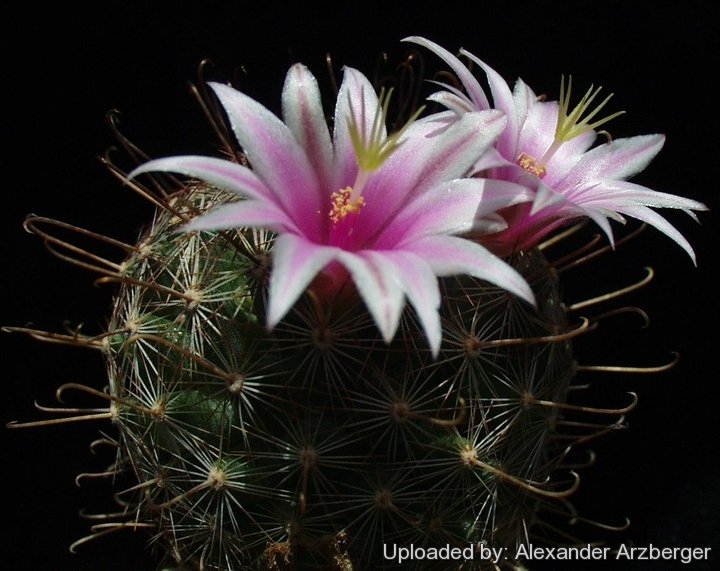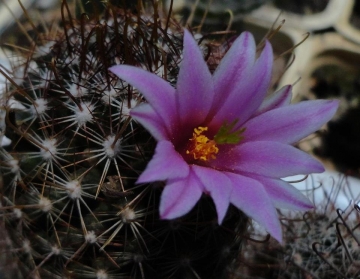Accepted Scientific Name: Mammillaria grahamii Engelm.
Syn. Cact. U. S. 6. 1856 Proc. Amer. Acad. Arts 3: 262. 1857 Engelm.

Mammillaria microcarpa var. auricarpa Photo by: Alexander Arzberger
Origin and Habitat: U.S.A. (Arizona).
Synonyms:
See all synonyms of Mammillaria grahamii
back
Accepted name in llifle Database:Mammillaria grahamii Engelm.Syn. Cact. U. S. 6. 1856 Proc. Amer. Acad. Arts 3: 262. 1857Synonymy: 26
Accepted name in llifle Database:Mammillaria grahamii subs. sheldonii (Britton & Rose) D.R.HuntCactaceae Syst. Init. 20: 21. 2005 [Nov 2005]Synonymy: 33
back
Description: Mammillaria microcarpa var. auricarpaSN|9189]]SN|9206]] 9206]SN|9189]] , suggesting that there is not really a fundamental difference between the two. The name auricarpa, meaning "golden yellow yellow fruits", refers to the peculiar colour of mature berries. The yellow coloured fruits (never red), and pale yellow central spines helps distinguish this variety from the other red fruiting forms.
Subspecies, varieties, forms and cultivars of plants belonging to the Mammillaria grahamii/sheldonii group
 Mammillaria alamensis R.T.Craig: (Mammillaria grahamii subs. sheldonii) without or with only 1 central spine, about 9 radial spines, white, tipped brown, needle-like, about 6 to 8 mm long. Distribution: Sierra de Alamos, Alamos, Sonora, Mexico.
Mammillaria alamensis R.T.Craig: (Mammillaria grahamii subs. sheldonii) without or with only 1 central spine, about 9 radial spines, white, tipped brown, needle-like, about 6 to 8 mm long. Distribution: Sierra de Alamos, Alamos, Sonora, Mexico. Mammillaria grahamii Engelm.: has 20-35 white to greyish to light brown to reddish radial spines. 1-4 central spines yellowish to dark brown central, one usually hooked. It is very variable. Distribution: California, Arizona, New Mexico and Texas, USA; Sonora, Sinaloa and Chihuahua, Mexico.
Mammillaria grahamii Engelm.: has 20-35 white to greyish to light brown to reddish radial spines. 1-4 central spines yellowish to dark brown central, one usually hooked. It is very variable. Distribution: California, Arizona, New Mexico and Texas, USA; Sonora, Sinaloa and Chihuahua, Mexico. Mammillaria grahamii subs. sheldonii (Britton & Rose) D.R.Hunt: has 9-24 radial spines. Central spines either straight or hooked, 1-1,5 cm long. Flowers purplish-pink with a pinkish brown midstripe. It is variable. Distribution: Mexico (Sonora and Chihuahua).
Mammillaria grahamii subs. sheldonii (Britton & Rose) D.R.Hunt: has 9-24 radial spines. Central spines either straight or hooked, 1-1,5 cm long. Flowers purplish-pink with a pinkish brown midstripe. It is variable. Distribution: Mexico (Sonora and Chihuahua). Mammillaria gueldemanniana Backeb.: aside from bigger flowers, not many differences. Distribution: Mexico, Chihuahua, Sonora and Sinaloa.
Mammillaria gueldemanniana Backeb.: aside from bigger flowers, not many differences. Distribution: Mexico, Chihuahua, Sonora and Sinaloa. - Mammillaria gueldemanniana var. guirocobensis (R.T.Craig) Backeb.: (Mammillaria grahamii subs. sheldonii) has 1-3 reddish-brown central spines almost 1 cm long. One spine is hooked. Flowers bigger and widely open. Distribution: Sonora, Sinaloa, Chihuahua at higher altitudes.
- Mammillaria inaiae R.T.Craig: (Mammillaria grahamii subs. sheldonii)
- Mammillaria marnieriana Backeb.: (Mammillaria grahamii subs. sheldonii)
 Mammillaria microcarpa Engelm. in Emory: (Mammillaria grahamii) has 15-35 pale radial spines and 1-3, yellowish-brown to purplish black centrals, the longest hooked. Fruits scarlet. Distribution: USA (Texas, New Mexico, Utah, California and Arizona) and Mexico.
Mammillaria microcarpa Engelm. in Emory: (Mammillaria grahamii) has 15-35 pale radial spines and 1-3, yellowish-brown to purplish black centrals, the longest hooked. Fruits scarlet. Distribution: USA (Texas, New Mexico, Utah, California and Arizona) and Mexico. Mammillaria microcarpa var. auricarpa W.T.Marshall: (Mammillaria grahamii) has pale, radial spines and a yellowish brown hooked central spine. Flowers are 4 cm in diameter, pink, and are followed by golden yellow berries. Distribution: U.S.A. (Arizona).
Mammillaria microcarpa var. auricarpa W.T.Marshall: (Mammillaria grahamii) has pale, radial spines and a yellowish brown hooked central spine. Flowers are 4 cm in diameter, pink, and are followed by golden yellow berries. Distribution: U.S.A. (Arizona).  Mammillaria microcarpa f. cristata hort.: crested form.
Mammillaria microcarpa f. cristata hort.: crested form.- Mammillaria oliviae Orcutt: (Mammillaria grahamii)
 Mammillaria pseudoalamensis Backeb.: (Mammillaria grahamii subs. sheldonii) variant recognisable from M. alamensis for the absence of central spines, and larger flowers with a characteristic distinctive orange pistil. Distribution: West of Alamos, Sonora, Mexico.
Mammillaria pseudoalamensis Backeb.: (Mammillaria grahamii subs. sheldonii) variant recognisable from M. alamensis for the absence of central spines, and larger flowers with a characteristic distinctive orange pistil. Distribution: West of Alamos, Sonora, Mexico. Mammillaria swinglei (Britton & Rose) Boed.: (Mammillaria grahamii subs. sheldonii) has wide funnelform purplish pink flowers up to 3. Stile style pink, twice as long as the pink filaments; stigma-lobes 8, linear, pointed, green.
Mammillaria swinglei (Britton & Rose) Boed.: (Mammillaria grahamii subs. sheldonii) has wide funnelform purplish pink flowers up to 3. Stile style pink, twice as long as the pink filaments; stigma-lobes 8, linear, pointed, green.
Bibliography: Major references and further lectures
1) Terry Smale “Notes on the 1979 Seed Distribution” The Cactus and Succulent Journal of Great Britain Volume 41 Number 1 February 1979 page 15
 Mammillaria microcarpa var. auricarpa Photo by: Alexander Arzberger
Mammillaria microcarpa var. auricarpa Photo by: Alexander ArzbergerSend a photo of this plant.The gallery now contains thousands of pictures, however it is possible to do even more. We are, of course, seeking photos of species not yet shown in the gallery but not only that, we are also looking for better pictures than those already present.
Read More... Cultivation and Propagation: Mammillaria microcarpa var. auricarpa is a large-flowered mammillaria which is sometimes difficult to cultivate. This plant blooms easily and needs lots of light. Use a pot with good drainage and a very porous mineral-based potting mix. Potted plants are quite wet-sensitive, especially in light of its small root system. Water sparingly during the growing season, let soil dry in between to prevent root rot, keep very dry in winter. Feed with a high potassium fertilizer in summer.
Usually it is recommended to over-winter this plant in a bright and warm greenhouse with at least 8-10° C, but it has proven to be quite frost resistant (if kept dry it is hardy as low as -7° C). A resting period in winter and strong light are necessary so that it can flower properly.
Propagation: Through seeds and cuttings.
More...











